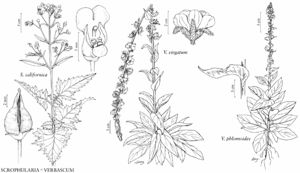Difference between revisions of "Verbascum phlomoides"
Sp. Pl. 2: 1194. 1753.
FNA>Volume Importer |
FNA>Volume Importer |
||
| Line 60: | Line 60: | ||
|publication year=1753 | |publication year=1753 | ||
|special status=Weedy;Introduced;Selected by author to be illustrated | |special status=Weedy;Introduced;Selected by author to be illustrated | ||
| − | |source xml=https://jpend@bitbucket.org/aafc-mbb/fna-data-curation.git/src/ | + | |source xml=https://jpend@bitbucket.org/aafc-mbb/fna-data-curation.git/src/f6b125a955440c0872999024f038d74684f65921/coarse_grained_fna_xml/V17/V17_56.xml |
|genus=Verbascum | |genus=Verbascum | ||
|species=Verbascum phlomoides | |species=Verbascum phlomoides | ||
Revision as of 18:30, 24 September 2019
Biennials. Stems (30–)50–200 cm, densely and persistently tomentose, eglandular. Leaves: surfaces densely and persistently tomentose, eglandular; basal and proximal cauline with petiole 40–80 mm; blade ovate-lanceolate to ovate-elliptic or oblong, (10–)15–25(–35) × 4–10(–15) cm, base attenuate; cauline subauriculate-clasping, gradually smaller distally, base not decurrent, rarely slightly so, margins entire or shallowly crenate, apex of distal cauline and floral bracts caudate-acuminate to short-acuminate. Inflorescences unbranched, narrowly cylindric, flowers densely overlapping or remote proximally, in clusters of 2–9; rachis densely and persistently tomentose, eglandular; bracts ovate-lanceolate, 9–15 mm, base short-decurrent or not at all, apex acute to short-acuminate, densely and persistently tomentose, eglandular. Pedicels adnate to rachis at base, 2–8(–15) mm; bracteoles 2. Flowers: calyx 5–12 mm, densely and persistently tomentose, eglandular, lobes lanceolate to triangular; corolla yellow, 30–55 mm diam., pellucid glands absent or relatively few; proximal filaments glabrous at least distally, distal pair villous, hairs white or yellow; stigma spatulate, base decurrent. Capsules elliptic-ovoid, 5–8 mm, tomentose. 2n = 32.
Phenology: Flowering Jun–Aug.
Habitat: Fields, roadsides, disturbed sites.
Elevation: 0–600 m.
Distribution
Alta., B.C., Man., Ont., P.E.I., Que., Sask., Ark., Colo., Conn., Del., D.C., Ga., Ill., Ind., Iowa, Ky., Maine, Md., Mass., Mich., Minn., Mo., N.J., N.Y., N.C., Ohio, Oreg., Pa., R.I., S.C., Tenn., Vt., Va., Wash., W.Va., Wis., Europe, Asia, introduced also in South America (Ecuador), Pacific Islands (New Zealand).
Discussion
In the flora area, Verbascum phlomoides is known from a single location each in Manitoba (near Roseisle) and Saskatchewan (near Moose Jaw). The record for Washington possibly is only a waif (King County, Seattle, in waste ground, introduced from Europe, 12 September 1936, W. J. Eyerdam s.n., SMU), because it apparently has not been recorded there since.
Verbascum ×kerneri Fritsch is a hybrid between V. phlomoides and V. thapsus.
Selected References
None.
